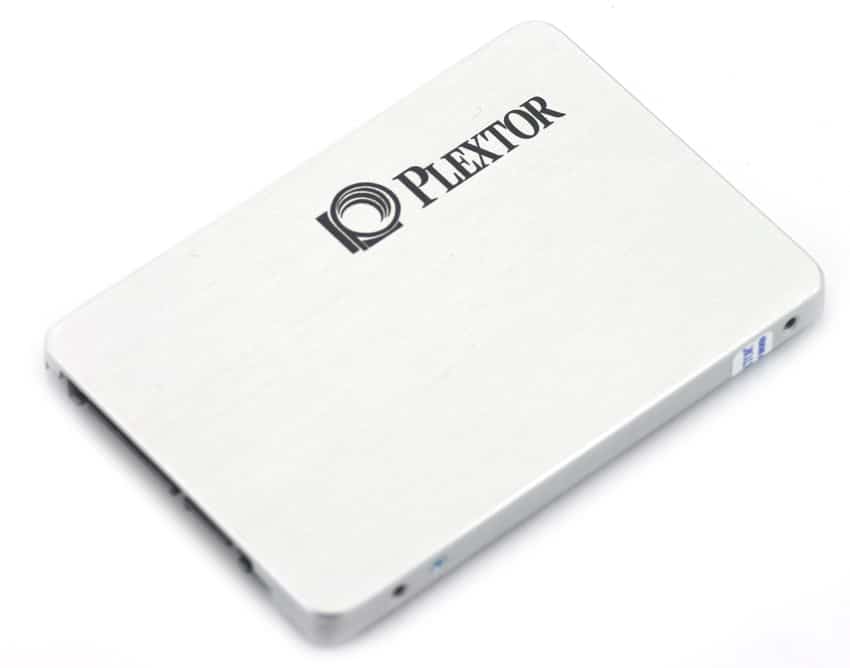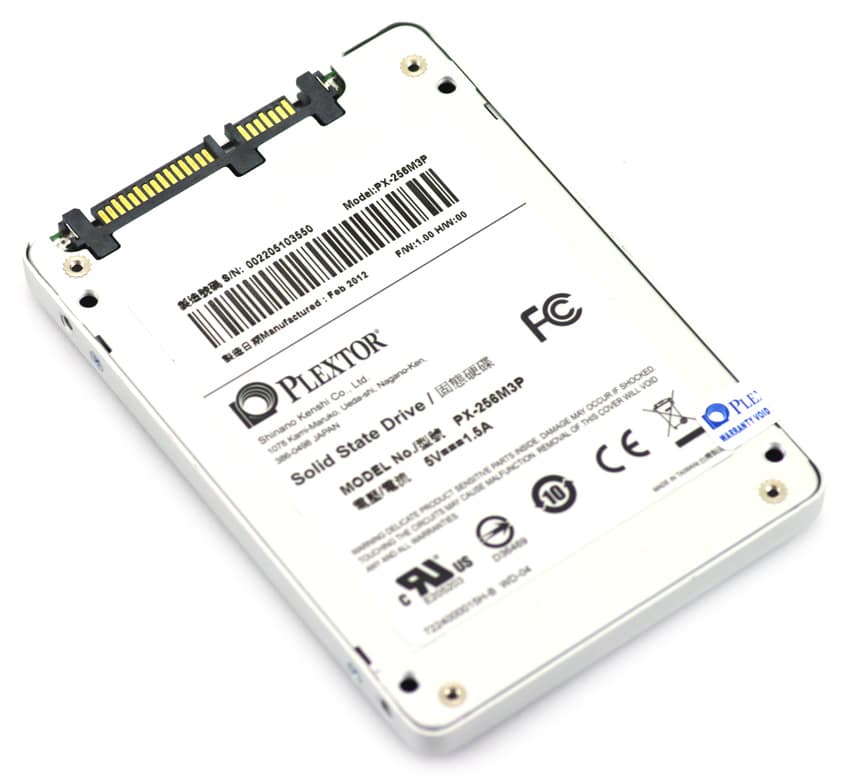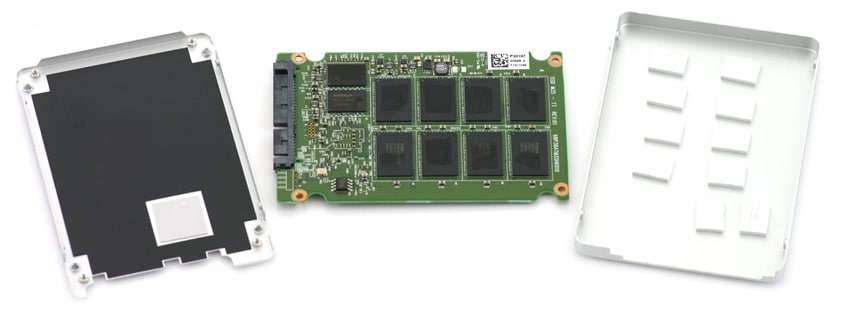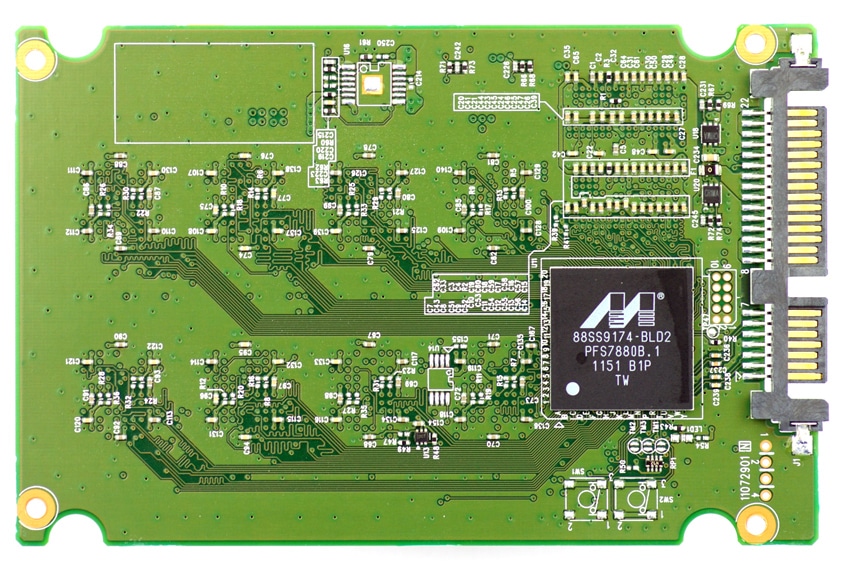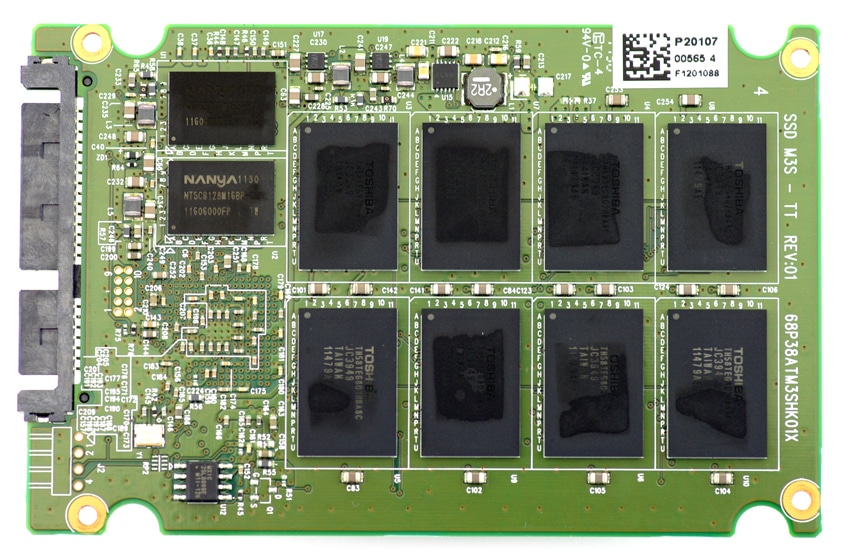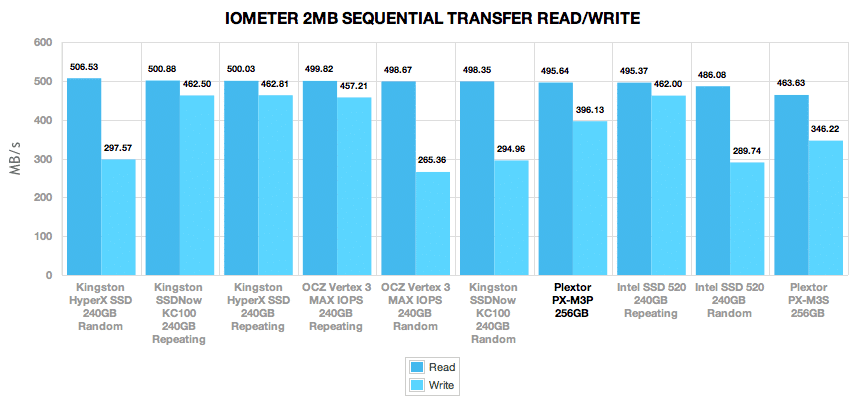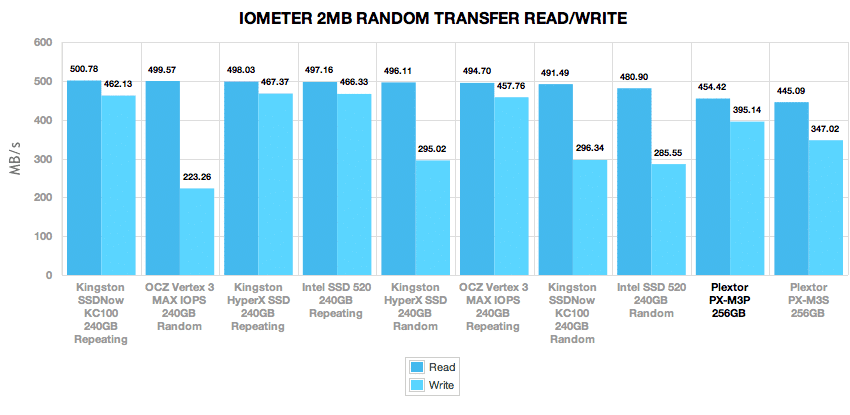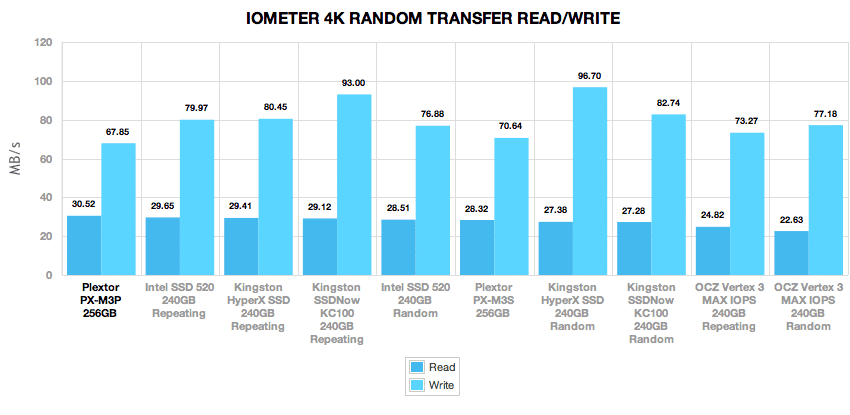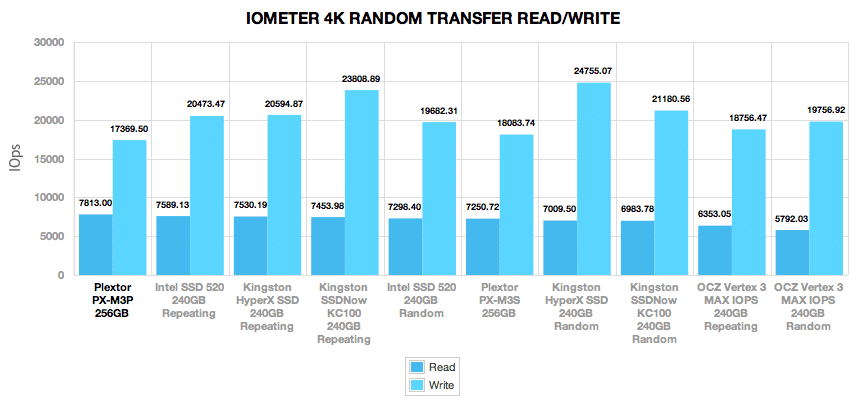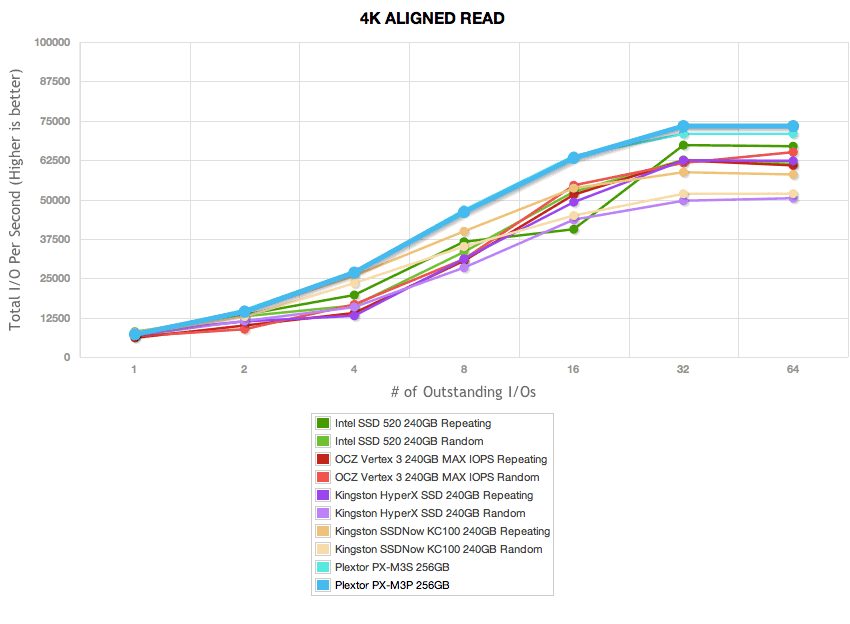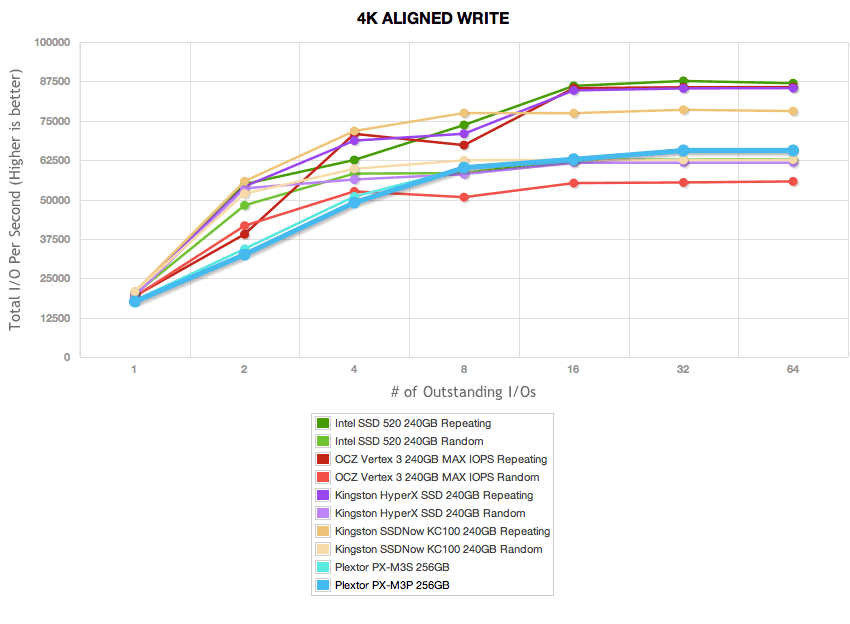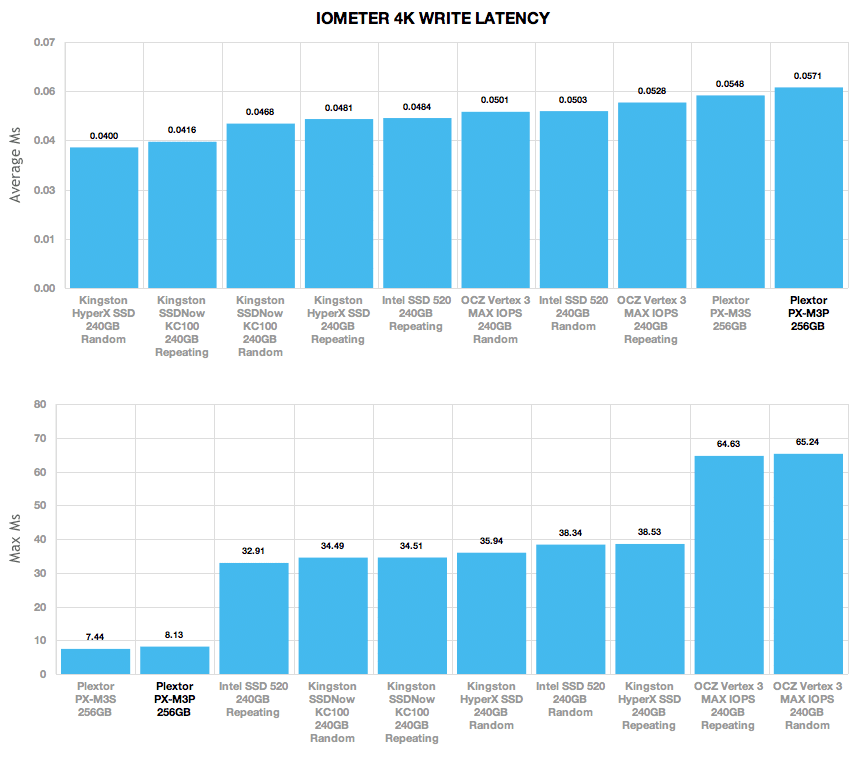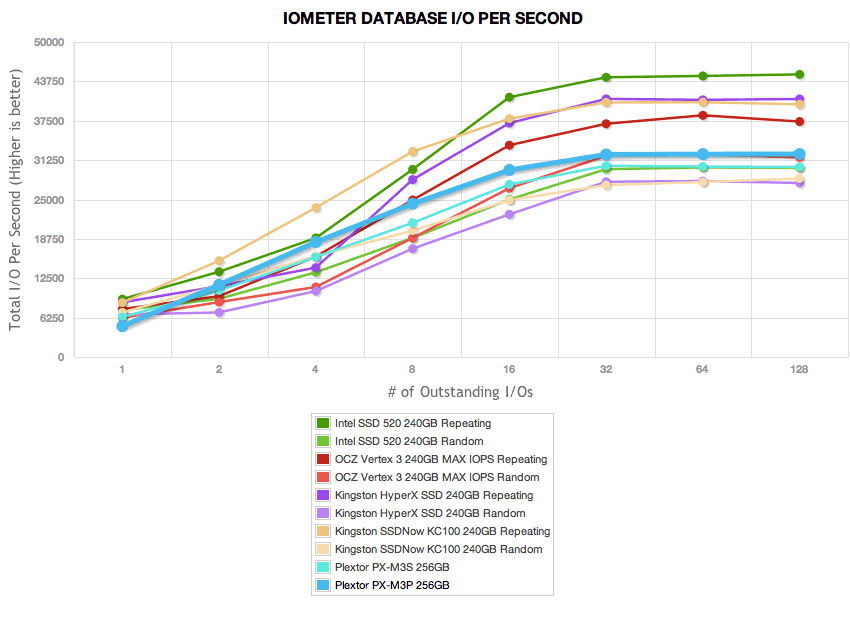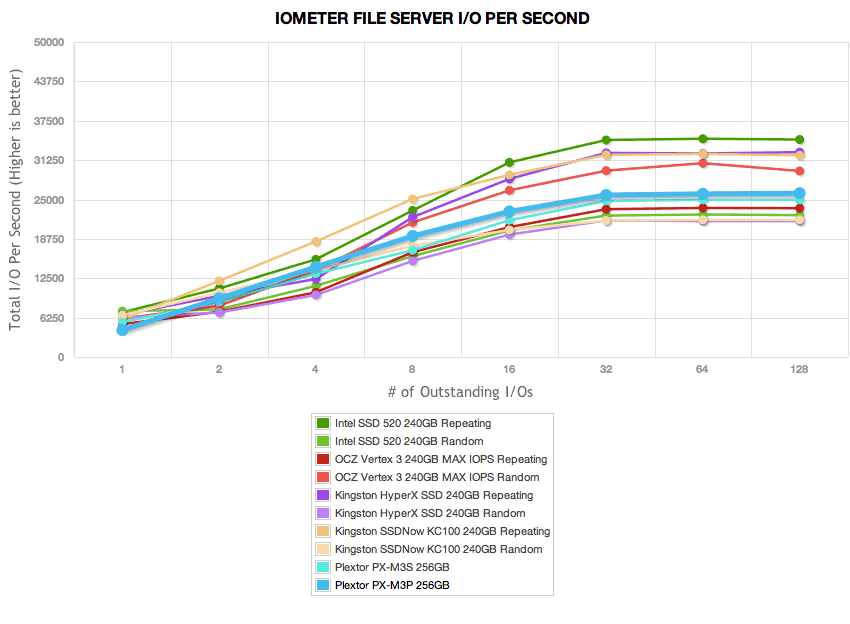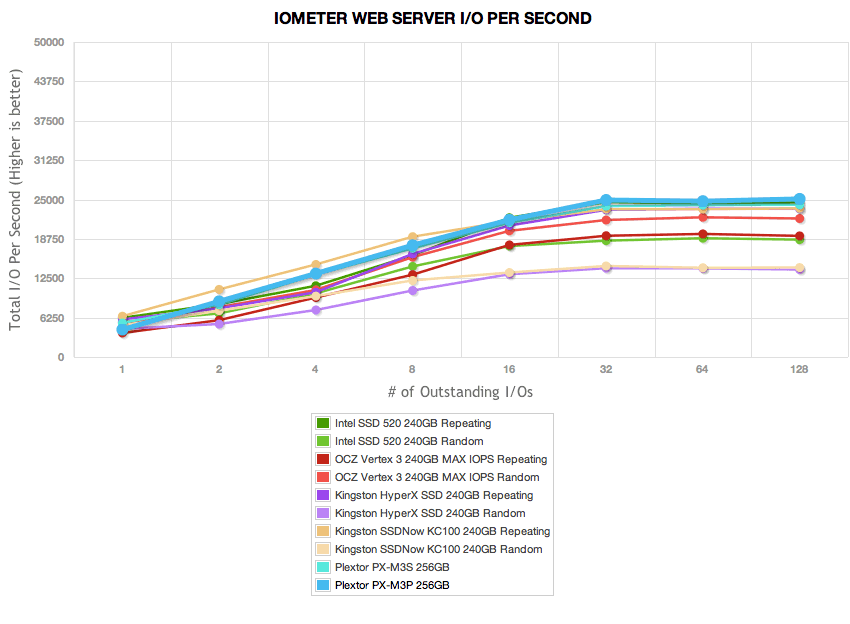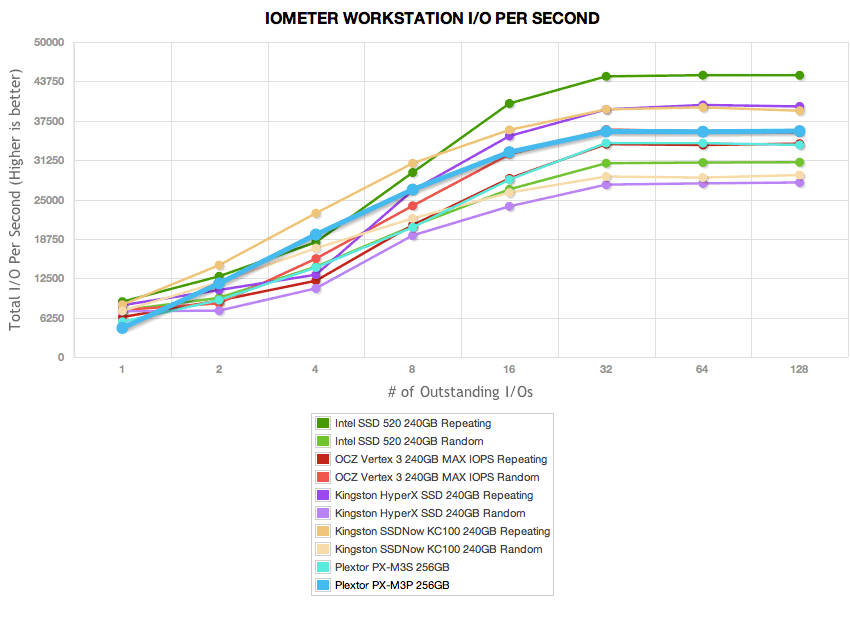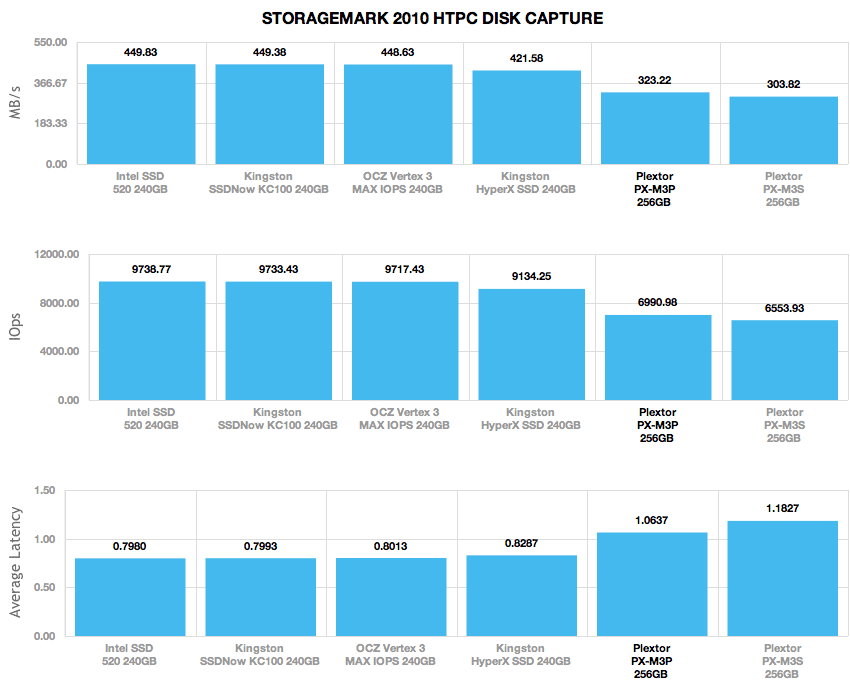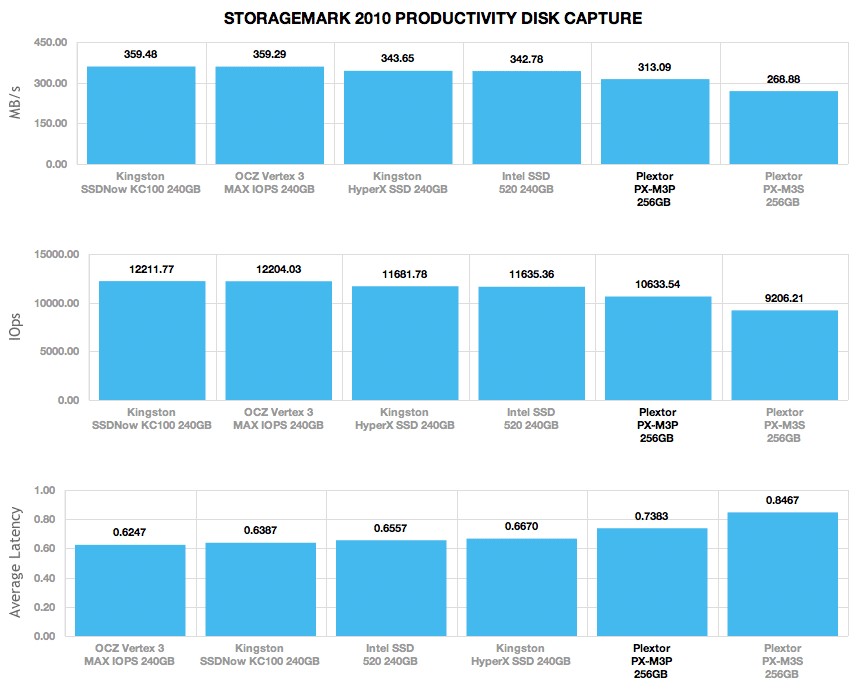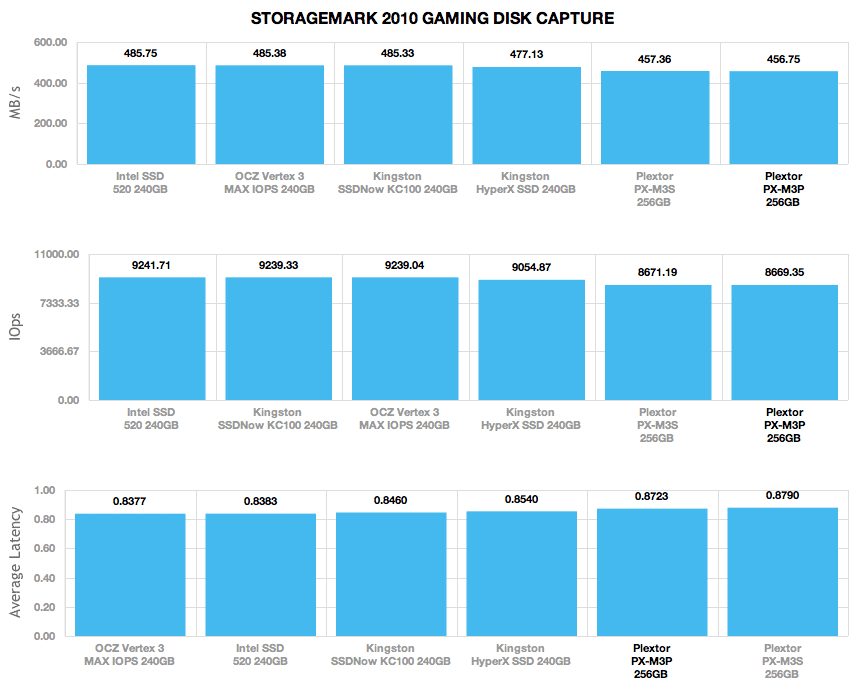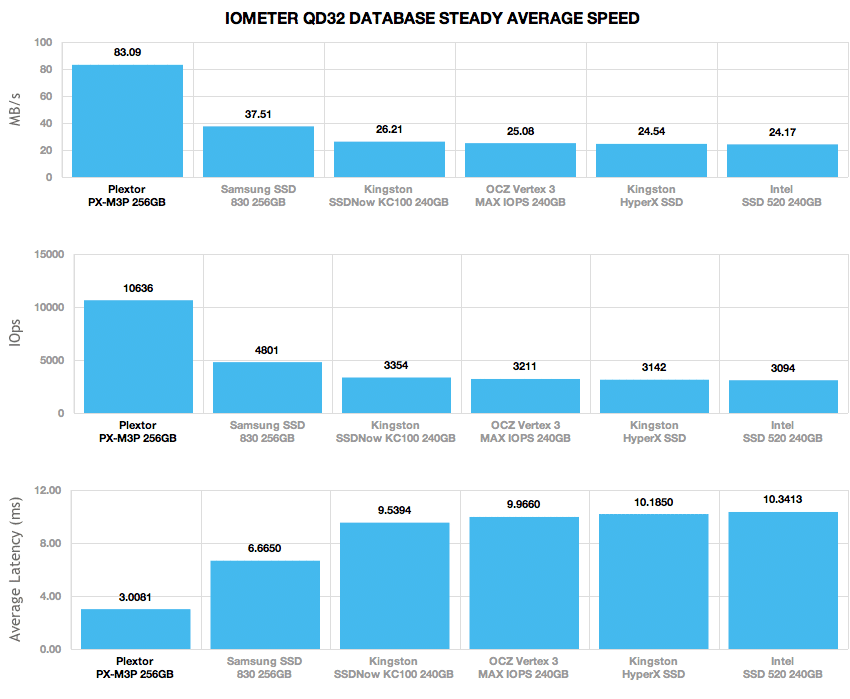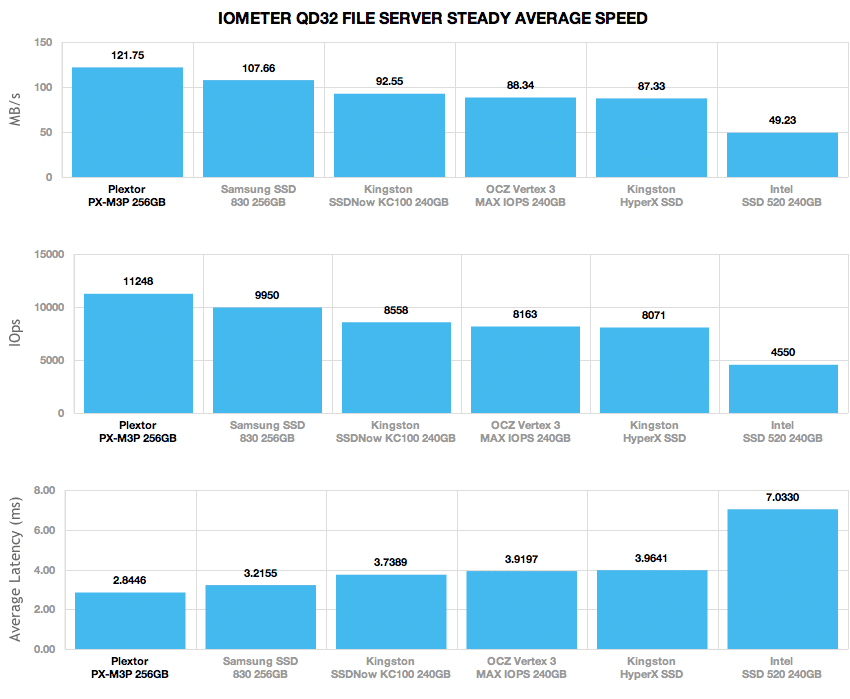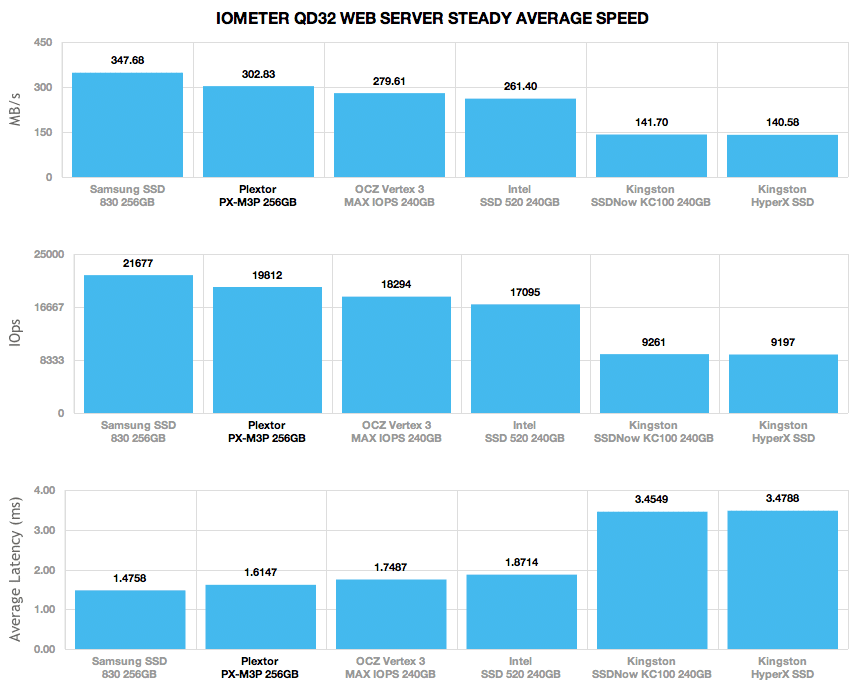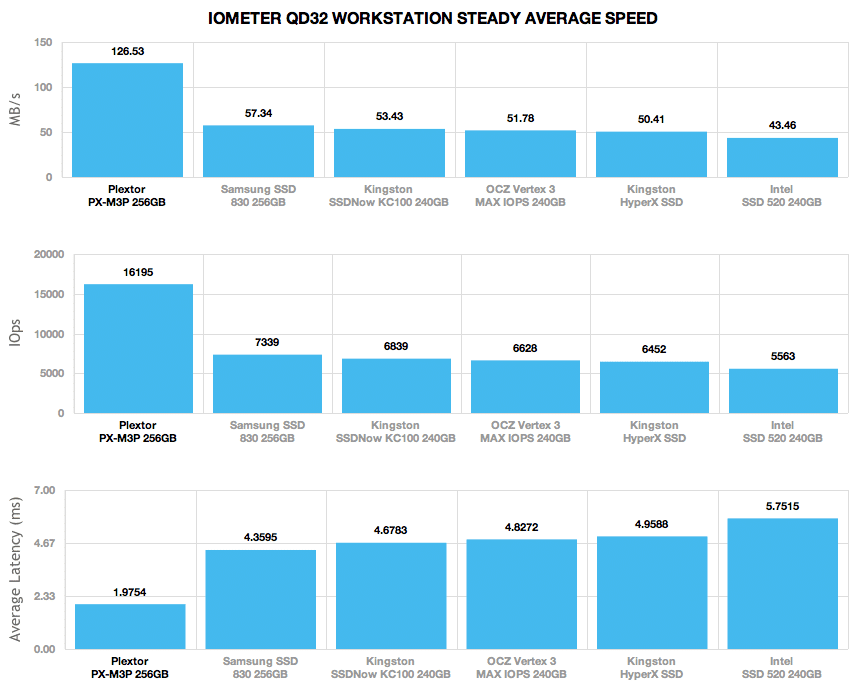
When we reviewed the Plextor M3S last year, it earned an Editor’s Choice award for excellent read performance, aggressive pricing and class leading support with the included five year warranty. At CES in January, Plextor showed us the upcoming M3P (P stands for Pro), which from a hardware perspective is nearly identical to the M3S, they both use the same Marvell controller and Toshiba Toggle NAND, but the M3P uses a 7mm form factor to be friendly with space constrained devices. The big difference though is firmware; the Plextor M3P is designed to post the fastest Marvell-based SSD speeds yet, with 540MB/s read and 450MB/s write sequential and upwards of 75,000 IOPS read and 69,000 IOPS write.
Aside from the new firmware, battle-tested NAND and processor combo and five year warranty, Plextor also includes a technology called True Speed with their SSDs, which provides for better drive performance over time. Plextor offers the M3 Pro in simplified 128GB, 256GB and 512GB capacities with MSRPs of $219.99, $389.99 and $729.99 respectively.
Plextor PX-M3P Specifications:
- Capacities
- 128GB (PX-128M3P)
- Sequential Read – 535 MB/s
- Sequential Write – 350 MB/s
- Random Read 4K IOPS – 75,000
- Random Write 4K IOPS- 69,000
- Cache 256MB
- 256GB (PX-256M3P)
- Sequential Read – 540 MB/s
- Sequential Write – 420 MB/s
- Random Read 4K IOPS – 75,000
- Random Write 4K IOPS- 68,000
- Cache – 512MB
- 512GB (PX-512M3P)
- Sequential Read – 535 MB/s
- Sequential Write – 450 MB/s
- Random Read 4K IOPS – 56,000
- Random Write 4K IOPS- 34,000
- Cache – 512MB
- 128GB (PX-128M3P)
- Marvell 88SS9174-BLD2 SSD controller
- 24nm Toshiba Toggle NAND
- Power Consumption (Typical) 0.1W (Idle); 5W (Active)
- Temperature (Operating) 32 ºF to 158 ºF (0 ºC to 70 ºC)
- Temperature (Non-operating) -40ºF to 185 ºF (-40 ºC to 85 ºC)
- Shock 1,500G/0.5 ms, Vibration (Operating) 7~800Hz, 2.17G (RMS)
- MTBF 1.5 million hour
- Warranty 5 year
- Data Encryption Supported
- Dimensions (W x H x D) 2.75 x 0.3 x 4.0 inch
- Weight 1.94 ~ 3.53
Aesthetics
Plextor uses an all-metal body with the PX-M3P, giving it a durable feel and a stylized look. The silver metal alloy used is presented with a brushed finish, adding a bit of texture and a very solid feel with the drive in your hand. Both top and bottom match in color and finish, which adds to the appearance and really rounds off this SSD.
The side of the drive shows off the screws that hold the two case halves together, as well as standard horizontal mounting points. The bottom also includes mounting points as well for attaching this drive to sleds and hot-swap bays. From the side vantage point you can see the short height of the 7mm size clearly.
The front of the drive includes the standard SATA power and data interface, with no service pins visible or other attributes.
Disassembly
Taking the Plextor PX-M3P apart is very simple, but voids your warranty in the process. To split the SSD apart, you remove the four Phillips head screws from the perimeter of the drive (one breaking the warranty voiding sticker) and then use a fingernail to split the case open.
Plextor uses thermal pads for each primary component of the SSD, including the eight pieces of NAND, two SDRAM pieces, as well as the controller. For a high-performance setting, this is a must to keep the electronics working under stress without getting too hot. In this setting the case acts as one large heatsink, passing heat into the chassis and surrounding airflow.
From the bottom of the SSD, you can see the Marvell 88SS9174-BLD2 controller used inside the PX-M3P SSD. This controller is also used in a wide range of models, including SSDs from Micron/Crucial as well as Corsair.
The 256GB capacity of the PX-M3P SSD uses eight 32GB 24nm Toshiba toggle NAND pieces, along with two 256MB SDRAM chips for cache.
Further driving home the fact that there were no hardware changes with this particular SSD is the “SSD M3S” stamp on the PCB, meaning all performance differences are from firmware.
Client Synthetic Benchmarks
The Plextor PX-M3P uses Toshiba’s 24nm consumer MLC NAND, a Marvell 9174 controller and a 6.0Gb/s SATA interface; our review unit is 256GB. The comparables used for this review include the following recently tested SSDs: Intel SSD 520 (240GB, SandForce SF-2281, Intel 25nm NAND, SATA), Kingston HyperX SSD (240GB, SandForce SF-2281, Intel 25nm MLC NAND, SATA), OCZ Vertex 3 MAX IOPS (240GB, SandForce SF-2281, Toshiba 32nm MLC NAND, SATA), and the Kingston SSDNow KC100 (240GB, SandForce SF-2281, Intel 25nm MLC NAND, SATA). All IOMeter figures are represented as binary figures for MB/s speeds. All SSDs were tested on our client testing platform.
Plextor lists thePX-M3P as having a peak sequential read speed of 540MB/s and a write speed of 450MB/s. We used IOMeter with a large-block transfer to see how the drive performed in our consumer test rig.
The M3 Pro posted a read speed of 495MB/s and a write speed of 396MB/s, which unlike models that use SandForce processors, offers that speed regardless of the type of data being written. This model will have no slow-down from incompressible data.
Our next test sticks with the same large-block transfer but switches from sequential to random transactions.
With a randon large-block transfer the M3P’s read speed dropped slightly to 454MB/s and the write speed stayed relatively the same at 395MB/s.
With the bread and butter of SSDs being their 4K random I/O speed, we look at low-queue depth performance, as well as expanded performance to see how well performance scales under higher queue depths.
The Plextor M3P raised the bar with 4K random read performance at a low queue depth, measuring 7,813 IOPS or 30.52MB/s at a queue depth of 1. Write speed lagged behind the SandForce-equipped models though, measuring only 17,369 IOPS or 67.85MB/s.
The next set of tests looks at expanded performance, to measure burst 4K read and write speed, as well as measure the peak I/O levels.
Expanding the 4K random read performance out through higher queue depths, the Plextor M3 Pro led the pack with a top speed of 73,323 IOPS.
Looking at expanded 4K write performance, the M3P stayed slightly ahead of the pack when compared the SandForce models working with incompressible data.
Expanding our low-queue depth 4K read and write test, we look at write latency of each SSD. Lower numbers are better, since it means less wait time for activity to process. Max latency is also important, although that number can change as the NAND wears over time. The Plextor PX-M3P measured 0.0571ms with a ultra-low peak latency of 8.13ms.
Our last group of consumer IOMeter synthetic benchmarks looks at mixed-load server profiles including Database, Workstation, File Server, and Webserver. In this setting the Plextor PX-M3P measured middle of the pack, below the SandForce models working with compressible data, but above those same drives when the dataset was switched to incompressible.
Client Real-World Benchmarks
For the average consumer, trying to translate random 4K write speeds into an everyday situation is pretty difficult. It helps when comparing drives in every setting possible, but it doesn’t exactly work out into faster everyday usage or better game loading times. For this reason we turned to our StorageMark 2010 traces, which include HTPC, Productivity, and Gaming traces to help readers find out how a drive might rank under their conditions.
The first real-life test is our HTPC scenario. In this test we include: playing one 720P HD movie in Media Player Classic, one 480P SD movie playing in VLC, three movies downloading simultaneously through iTunes, and one 1080i HDTV stream being recorded through Windows Media Center over a 15 minute period. Higher IOps and MB/s rates with lower latency times are preferred. In this trace we recorded 2,986MB being written to the drive and 1,924MB being read.
Compared to the M3S, the new Plextor M3P showed an increase of performance in our HTPC trace, going from 303.82MB/s average to 323.22MB/s. Both of these drives trailed behind the SandForce-equipped models though, which offered the fastest speeds.
Our second real-life test covers disk activity in a productivity scenario. For all intents and purposes this test shows drive performance under normal daily activity for most users. This test includes: a three hour period operating in an office productivity environment with 32-bit Vista running Outlook 2007 connected to an Exchange server, web browsing using Chrome and IE8, editing files within Office 2007, viewing PDFs in Adobe Reader, and an hour of local music playback with two hours of additional online music via Pandora. In this trace we recorded 4,830MB being written to the drive and 2,758MB being read.
In our Productivity setting, the M3P continued to offer improvements over the M3S, with an average speed of 313.09MB/s compared to 268.88MB/s.
Our third real-life test covers disk activity in a gaming environment. Unlike the HTPC or Productivity trace, this one relies heavily on the read performance of a drive. To give a simple breakdown of read/write percentages, the HTPC test is 64% write, 36% read, the Productivity test is 59% write and 41% read, while the gaming trace is 6% write and 94% read. The test consists of a Windows 7 Ultimate 64-bit system pre-configured with Steam, with Grand Theft Auto 4, Left 4 Dead 2, and Mass Effect 2 already downloaded and installed. The trace captures the heavy read activity of each game loading from the start, as well as textures as the game progresses. In this trace we recorded 426MB being written to the drive and 7,235MB being read.
In our Gaming trace with a strong read-preference, the M3P didn’t offer a huge boost compared to the M3S, with speeds measuring 457.36MB/s and 456.75MB/s respectively.
Enterprise Synthetic Benchmarks
In an enterprise setting, initial burst is hardly relevant if after one hour of use the drive will never see that speed again. This is where steady state benchmarking comes in, showing how the drive performs when under a 24/7 load. For this reason, all of the following benchmarks were pre-conditioned and recorded in a steady-state mode.
We used our StorageReview Enterprise Testing Environment to benchmark the Plextor PX-M3P SSD; accurately representing its capabilities in an enterprise environment. The enterprise testing platform is based around a Lenovo ThinkServer RD240, equipped with dual Intel Xeon X5650 processors, running Windows Server 2008 R2. For single-drive benchmarks we connect each SSD through an LSI SAS 9211-8i HBA to measure performance without any influence of caching. All IOMeter figures are represented as binary figures for MB/s speeds. All tests are performed in steady-state. Each of our server profile tests has a strong preference towards read activity, ranging from 67% read with our database profile to 100% read in our web server profile.
One thing to understand about steady-state benchmarking on SSDs, is that generally speaking, models with a higher level of over-provisioning perform better. This might put a drive like the Plextor M3P or Samsung SSD 830 at a disadvantage, but the other side of the equation is we test with fully incompressible data in this area, which is worst-case scenario for SandForce-equipped drives that increase speed by compressing data.
The first is our database profile, with a 67% read and 33% write workload mix primarily centered on 8K transfer sizes.
In an enterprise Database setting, the Plextor M3P had no trouble maintaining a huge performance lead over the Samsung SSD 830 or range of SandForce-equipped models. The M3P offered a speed of 10,636 I/O, compared to 4,801 I/O from the SSD 830, or low 3,000 I/O range from the SandForce-powered SSDs.
The next profile looks at a file server, with 80% read and 20% write workload spread out over multiple transfer sizes ranging from 512-byte to 64KB.
In a File Server setting, the Plextor M3P maintained its strong lead over the other SSDs, with an average speed of 11,248 I/O.
Our web server profile is read-only with a spread of transfer sizes from 512-byte to 512KB.
Even in a read-only setting the Plextor M3P performed very well, coming in second to the Samsung SSD 830. Both drives offered a huge performance boost over the other client-based SandForce SSDs.
The last profile looks at a workstation, with a 20% write and 80% read mixture using 8K transfers.
Similar to our Database test, the Plextor M3P showed a huge performance lead in our Workstation profile, with an average speed of 16,195 I/O compared to 7,339 I/O from the SSD 830.
Power Consumption
When looking at any modern SSD, power consumption is a huge deciding factor for many mobile shoppers, since the drive itself can make up a large portion of the total power used in a given notebook. In our power consumption tests we look at how much a given drive draws during read and write activities, as well as startup requirements and idle.
Plextor lists an idle power consumption of 0.1 watt with an active power usage of 5 watts. In our tests we measured idle activity at 0.35 watts, with a peak of 3.58 watts during sequential write activity. Compared to the M3S, the M3P used slightly more power while writing to the drive, as well as in startup conditions. Every other setting was pretty much matched across the board.
Conclusion
The Plextor PX-M3P is generally a nice progressive update over the M3S, pretty impressive considering firmware is the only change between the two drives. When we look at top line 2MB speeds, we measured reads at 495MB/s and writes of 396MB/s, which is a boost of about 30 MB/s and 50 MB/s respectively over the M3S. And unlike SandForce-based SSDs, the M3P offers those speeds with both compressible and incompressible data. We also saw significant improvements in our traces and mixed workload tests, so gains weren’t just straight line performance boosts.
While generally viewed and marketed as a client SSD, the M3 Pro will likely be deployed as well in enterprise client scenarios and may even see entry enterprise use, specifically due to it’s superb steady state performance under enterprise workloads. While the M3P maintained a small lead in the file server results and came in second to the Samsung SSD 830 in the web server profile, the M3P posted massive leads in the database and workstation scenarios, coming in with nearly a 4x lead over the SandForce-equipped models in the database setting. Given the performance and relative cost, the PX-M3P stands to spread itself well beyond typical client system use.
As we look at more drives in continuous usage profiles, we see that performance similarities that exist in burst conditions fade away into bold and contrasting differences when a drive hits steady state. With its limited over-provisioning, the Marvell 9174-powered Plextor M3P still performed faster than any other consumer SSD we have tested in steady state with write activity included. In a read-only setting the Samsung SSD 830 was able to take lead, but in all other conditions the M3P had no trouble showing huge gains over the SandForce-equipped SSDs when working with incompressible data.
Pros
- Fastest consumer SSD in steady-state with write-activity
- No drop in performance from incompressible data
- 5 year warranty
- Excellent power consumption
Cons
- Slower in write burst speeds than SandForce-powered SSDs
- Less performance at lower-queue depths with random 4K activity
Bottom Line
Plextor has another unique SSD with the PX-M3P, showing that even on what’s an established platform, they’re able to engineer additional performance with a well-designed firmware package. The M3 Pro handles typical burst speeds well, but when under heavy load it really shines, delivering the best client SSD performance we’ve seen to date. Coupled with a five year warranty and excellent power numbers the M3P stands out as a top-tier client SSD.

